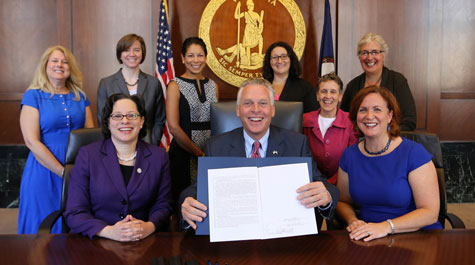Professor Hamilton Worked with Advocates and Legislature on New Law Restricting Underage Marriage in Virginia
A new law, which took effect on July 1, has raised the minimum age at which young people in Virginia may marry to 18. Prior to this month, 16- and 17-year-olds were free to marry in the Commonwealth with parental consent; those even younger could marry with parental consent if there was a pregnancy.
Professor Vivian Hamilton worked with advocates and the state legislature to create the bill and witnessed its ceremonial signing by Gov. Terry McAuliffe. She recently talked with William & Mary News about Virginia's new law.
What exactly does the new Virginia law require?
Under the new Virginia law, children under 16 may no longer marry — at all. But the law permits a court to allow 16- and 17-year-olds to marry if the judge conducting a hearing where both individuals intending to marry are present finds that the minor is entering the marriage voluntarily and is "mature enough" to make the decision to marry. In those cases, the judge may order the minor "emancipated" and thus able to marry.
The new law thus does away with the most troubling, youngest marriages. And by putting procedural safeguards in the way of 16- and 17-year-olds seeking to marry, we hope it will drastically reduce the occurrence of minors being coerced to marry. Those same procedural hurdles, moreover, will likely reduce the total number of minors aged 16 and 17 entering marriage.
How common is child marriage?
Many people are unaware that thousands of children and teens marry in the United States. In Virginia alone, almost 4,500 minors under age 18 were married between 2004 and 2013.
Some 90 percent of minor spouses in Virginia were girls, and many of them married men significantly older than they were — sometimes decades older. Advocates have identified cases where the previous law did nothing to prevent forced marriages, and it allowed abusers who could otherwise be prosecuted for statutory rape to evade prosecution by marrying their victims.
Even where minors enter marriages voluntarily, however, the social costs of child marriages are enormous.
What are some of the social costs of child marriage?
Marriages entered at young ages are the most unstable. That familiar statistic — that nearly half of all marriages end in divorce — obscures significant variation in marital stability, depending on the age at which couples marry. When individuals marry before age eighteen, the likelihood of divorce increases to 70 percent. And for the youngest child marriers, those aged sixteen and younger, marital failure rates approach a sobering 80 percent.
Researchers have found that individuals who marry early are more likely to discontinue their formal educations prematurely, earn low wages, and live in poverty than those who delay or avoid marriage. Women who marry in their teens are 50 percent more likely to drop out of high school and four times less likely to finish college than those who delay marriage.
Early marriages resulting from unintended pregnancies fare no better. Instead, teen mothers who marry between conception and childbirth are less likely to ever return to school than young mothers who delay marriage. And following divorce, mothers (and their children) tend to suffer greater economic deprivation and instability than do their never-married counterparts.
Women who marry early experience worse physical health and develop more mental health problems than those who marry later. Studies of women have found teen marriage to be significantly associated with mental disorders, particularly major depressive disorder. For women, teen marriage also correlates with heightened risk of heart attack, diabetes, cancer, and stroke.
Do we know why early marriages tend to exact such a toll on those families?
The reasons why the marriages of the young are so unstable are complex, but two factors likely interrelate to play a significant role. The first is economic: To earn a wage sufficient to support a family in today’s economy typically requires more years of education and training than can be acquired before age eighteen. Low-paying work and occupational instability hinder the ability to support a family. And financial insecurity stresses the marital relationship.
Marital stress is part of the second significant factor, which is relational. Throughout history, the meaning of marriage has evolved. Marriage today is imbued with greater symbolic and personal value than in previous decades. We expect more of our marriages — and marriage partners — today than at any other time in history. As a result, today’s marriages require relational capacities that depend on a level of psychosocial maturity that adolescents lack. And the marital relationship thus flounders.
Should other states copy and paste the new Virginia law into their state codes?
Virginia’s new law is a good start, and I hope that other states begin to change their laws along similar lines. An even better law, however, would prohibit child marriages altogether. Neither parental nor judicial consent has been found to provide a protective effect for these most fragile unions.
The bipartisan effort to improve Virginia’s marriage law is an example of the sort of legislative cooperation and progress that is all-too-absent in today’s legislative bodies. But, as with much social policy, it is part of a work in progress, and more remains to be done.
Hamilton’s areas of specialization include children and the law, civil procedure and family law. She has published The Age of Marital Capacity: Reconsidering Civil Recognition of Adolescent Marriage, Mistaking Marriage for Social Policy and Immature Citizens and the State.
About William & Mary Law School
Thomas Jefferson founded William & Mary Law School in 1779 to train leaders for the new nation. Now in its third century, America's oldest law school continues its historic mission of educating citizen lawyers who are prepared both to lead and to serve.
